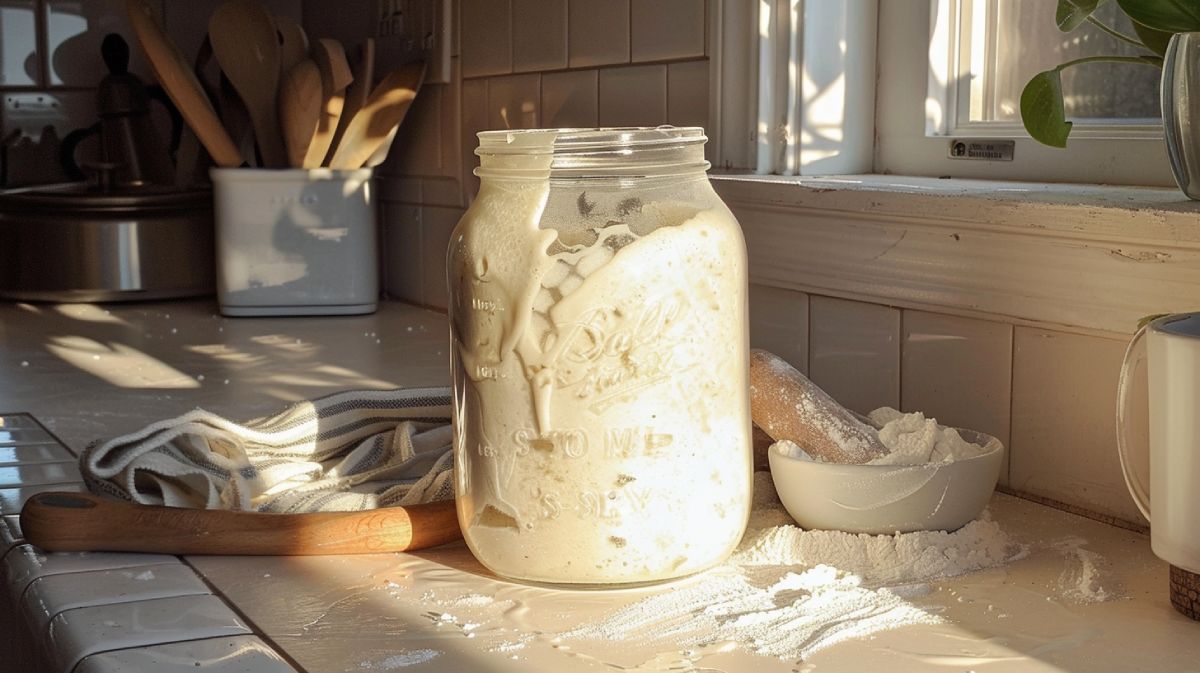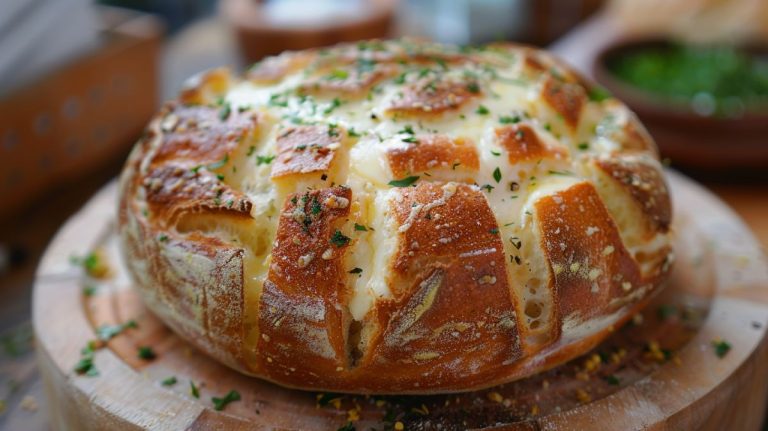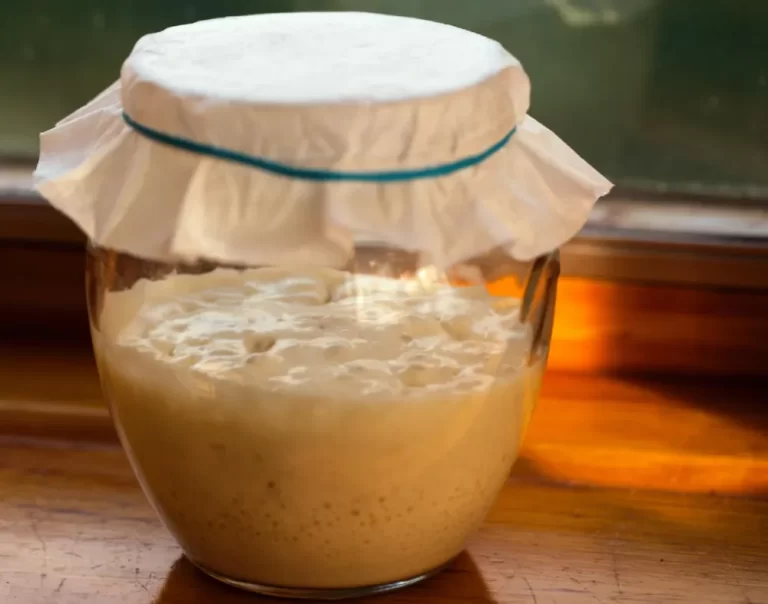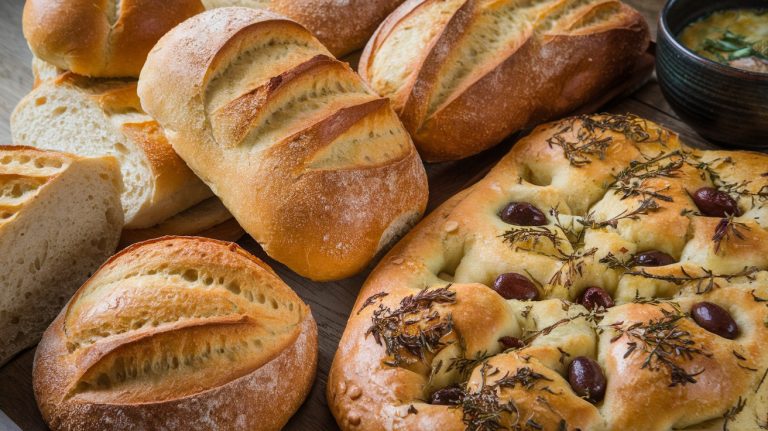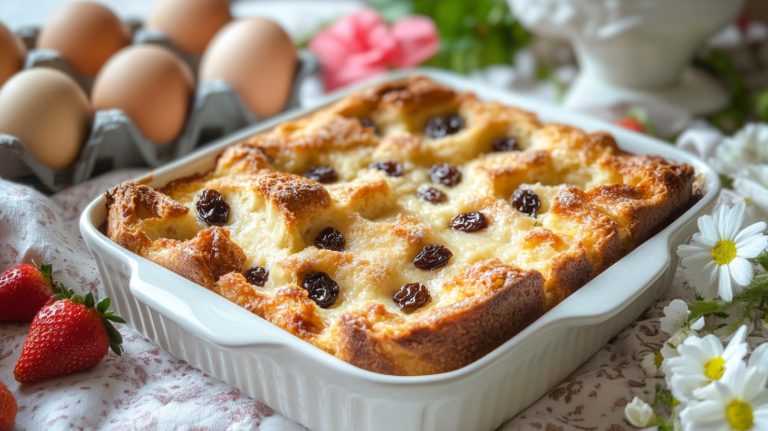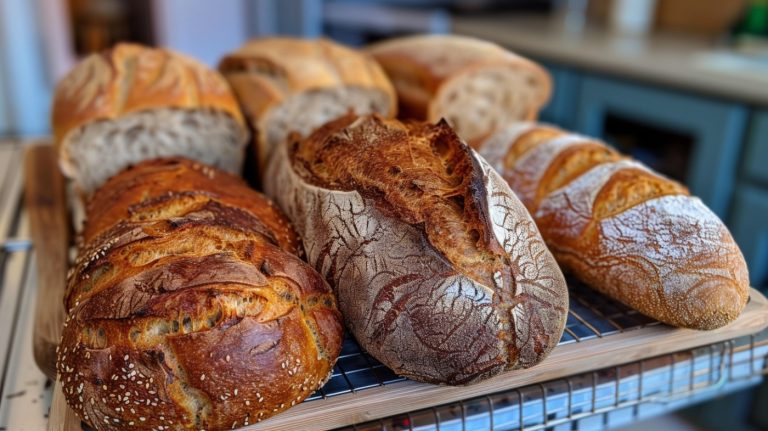What to Do if Sourdough Starter Overflows Jar?
If your sourdough starter overflows, don’t panic. First, transfer it to a larger container, leaving enough room for expansion. Use a jar with a loosely fitted lid to let gases escape. Clean the spill immediately with a damp cloth to prevent it from drying.
To manage high yeast activity, refrigerate your starter, especially in warm climates. Stir it down before feeding, and consider feeding less to reduce volume. Share excess starters with friends or use them in recipes like pancakes or waffles. With these precautions, you’ll master managing an enthusiastic starter and more.
Key Takeaways
- Transfer the starter to a larger jar to accommodate its expansion.
- Stir down the starter to reduce its volume and prevent further overflow.
- Refrigerate the starter to temporarily halt fermentation and slow down activity.
- Clean up any spills immediately to prevent them from drying and becoming harder to clean.
- Adjust feeding ratios or reduce the amount of starter to manage its growth better.
Causes of Overflow
One of the main causes of sourdough starter overflow is using a jar that’s too small to accommodate its expansion. When you feed your starter, it can double or even triple in size, and a small jar simply can’t handle that volume. You need to be proactive in selecting the appropriate size jar to prevent messy overflows. Opt for a jar that’s at least four times the volume of your starter.
High yeast activity is another culprit. Warm temperatures and frequent feedings accelerate yeast growth, leading your starter to rise more rapidly. If your kitchen is warm, consider using a larger jar to provide your starter more room to grow.
A tight, sealed lid can also worsen the issue by creating pressure buildup. Sourdough starters produce gas as they ferment, and if the gas has no way to escape, it can push the starter out of the jar. Instead, use a breathable cover like a cloth or a loose-fitting lid to allow gas to escape.
Lastly, if you’ve recently refreshed your starter, it’s more likely to overflow. Freshly fed starters are particularly active, so make sure you’re using a jar with ample space.
Storage Tips
To effectively manage your sourdough starter’s growth and prevent overflow, it’s crucial to store it in a well-chosen container. Opt for a larger mason jar that allows ample room for expansion. After refreshing your starter, make sure it fills the jar only halfway. This precaution helps prevent spillover as the starter ferments and expands.
While mason jars are popular, you might also consider a plastic container with a tight-fitting lid. Ensure the lid can release excess gas to avoid pressure buildup, which can lead to overflow. You don’t want to seal the lid tightly, as this can trap gases created during fermentation, causing the container to burst.
Refrigeration is another effective strategy. By storing your starter in the fridge, you temporarily halt fermentation, giving you better control over its growth. This method is particularly useful if you won’t be baking for a few days and want to manage the starter’s activity without daily feeding.
Encouraging Healthy Growth
Maintaining a strong sourdough starter requires consistent feeding and attention to its fermentation environment. To encourage healthy growth, it’s essential to feed the starter regularly. This involves discarding a portion and replenishing it with equal parts flour and water. Doing so guarantees active yeast and bacterial colonies remain well-nourished, preventing abnormal smells or colors.
Your starter should be bubbling and doubling in size within a few hours post-feeding, indicating a flourishing ecosystem. If it’s overflowing, that’s a sign of vigorous yeast activity. To manage this, make sure you’re using a container that allows for expansion, ideally only filling it halfway after renewing the starter. This gives the yeast ample room to grow without spilling over.
Temperature also plays a critical role. Keep your starter in a warm, stable environment, around 70-75°F (21-24°C), to promote consistent activity. If it’s too cold, the fermentation slows down; if it is too hot, it can become overactive too quickly.
Using Over-Active Starter
When your sourdough starter is bubbling over, it’s the perfect chance to get creative and adventurous in the kitchen.
Experiment with different recipes, like pancakes, waffles, or muffins, to make the most of your excess starter.
Don’t let any go to waste—share some with friends or family and explore sourdough discard recipes for resourceful baking.
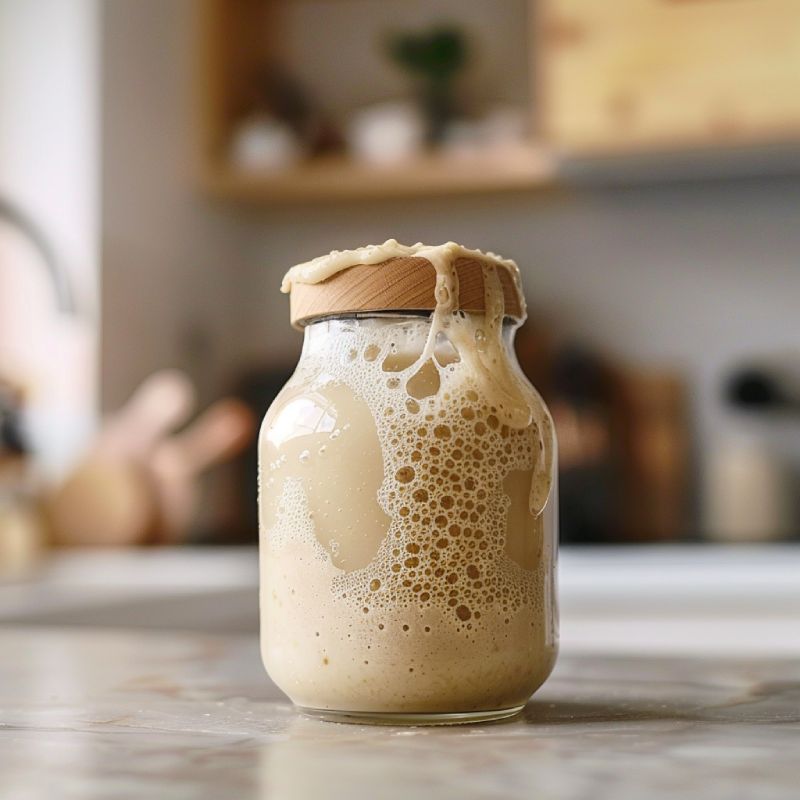
Managing Excess Starter
One important method for managing an overflowing sourdough starter involves stirring it down to prevent messy spills. When you notice your starter going wild, gently stir it back into the jar to redistribute the gases and reduce the risk of overflow.
To address the core issue, consider adjusting the feeding ratios. Reducing the starter size before feeding can help you manage its growth. For instance, if you’re maintaining a large amount, cut it down to a couple of tablespoons before adding flour and water. This safeguards you to have a more manageable amount of starter and minimizes the risk of another overflow.
Another effective strategy is transferring your starter to a larger jar. This gives it plenty of room to expand without making a mess. Additionally, opting for smaller portions when feeding can prevent future overflow. Instead of maintaining a large starter, keep a smaller amount and only increase it when you need more for baking.
Creative Recipe Ideas
Harness the potential of your over-active sourdough starter by integrating it into various recipes that elevate both flavor and texture. Don’t let that overflow go to waste; instead, turn it into delightful culinary creations that your family and friends will love.
Here are some expert recipe ideas to get you started:
- Pancakes and Waffles: Add excess starter to your pancake or waffle batter for a tangy twist and extra fluffiness. The natural fermentation will give your breakfast a unique depth of flavor.
- Muffins: Inject a sourdough twist into your muffins. Replace a portion of the usual liquid with your starter to create moist, tangy muffins that are perfect for any time of day.
- Pizza Dough: Elevate your homemade pizza by incorporating sourdough starter into the dough. The result is a beautifully chewy crust with a rich, complex flavor that store-bought dough can’t match.
- Crackers and Flatbreads: Use your active starter to make homemade crackers or flatbreads. These are perfect for snacking and will impress with their enhanced flavors and textures.
Sharing With Others
Sharing your over-active sourdough starter with friends, family, or neighbors not only helps prevent waste but also fosters a community of passionate home bakers. By introducing others to the art of sourdough baking, you’re spreading joy and knowledge.
Start by offering a portion of your starter along with simple instructions for feeding and maintaining it. You can even share a few of your favorite recipes to get them started.
Encourage your recipients to experiment with their new starter. Sourdough isn’t just for bread; it can transform pancakes, waffles, and muffins into tangy, flavorful delights. For those who love pizza, suggest incorporating the starter into their dough for a unique sourdough twist.
Collaborate with fellow bakers to exchange tips and recipes. This shared baking experience can lead to discovering new techniques and ideas.
Additionally, point them toward online resources where they can find innovative sourdough discard recipes to use any excess starter creatively.
Community Support
You’ll find invaluable support by joining online sourdough baking communities where experienced bakers share advice on managing an overflowing starter.
Local workshops and classes offer hands-on guidance, allowing you to master the nuances of sourdough care.
Engage with fellow enthusiasts to exchange troubleshooting tips and creative solutions.
Online Baking Communities
Have you ever wondered how online baking communities can transform your sourdough journey by providing expert advice and collective wisdom?
When your sourdough starter overflows its jar, turning to online forums and social media groups can be a game-changer. These platforms are teeming with experienced bakers who’ve faced similar issues and are enthusiastic to share their solutions.
By engaging with these communities, you can:
- Seek immediate advice: Get real-time troubleshooting tips for managing an overflowing sourdough starter.
- Share your experiences: Post about your own baking journey and receive feedback and encouragement.
- Access a wealth of knowledge: Browse through countless posts, tutorials, and videos dedicated to sourdough starter care.
- Build connections: Network with fellow bakers who share your passion and can offer ongoing support.
Joining an online baking community isn’t just about fixing immediate problems; it’s about immersing yourself in a collective pool of knowledge that can elevate your sourdough skills.
Whether you’re looking to adjust your feeding schedule, choose the right jar size, or fine-tune the hydration levels, these communities offer invaluable insights that can help you master your sourdough starter.
Don’t hesitate—dive into the world of online baking communities today!
Local Workshops and Classes
Local workshops and classes offer an invaluable opportunity for hands-on learning and practical solutions to manage your sourdough starter overflow effectively. When you join a local baking workshop, you gain access to expert guidance and real-time troubleshooting for common starter issues, including overflow. These classes often provide in-depth explanations of starter recipes, helping you understand the nuances of maintaining a healthy and manageable starter.
Engaging with other sourdough enthusiasts in a class setting allows you to share experiences and gain insights from people who’ve faced similar challenges. You can experiment with different techniques and receive immediate feedback from instructors and peers. This collaborative learning environment is incredibly beneficial for both novice and seasoned bakers.
Here’s a quick overview of the benefits of local workshops:
| Benefit | Description | Example |
|---|---|---|
| Hands-on Guidance | Practical tips and live demonstrations | Learn to adjust starter consistency |
| Community Support | Share experiences and solutions with fellow bakers | Group discussions on starter issues |
| Expert Instruction | Access to professional advice and starter recipes | Master best feeding schedules |
Cleaning Up Mess
To effectively clean up a sourdough starter mess, promptly wipe up any spills to prevent them from drying and becoming harder to remove. Begin by removing the jar of starter from the affected area, ensuring you put it back in a safe place to avoid further spills. If there are any dried spots, soak them with water to soften the starter, making it easier to clean.
Here’s a step-by-step to tackle the mess:
- Wipe Up Fresh Spills: Immediately use a damp cloth to wipe up any fresh spills. This prevents the starter from drying and sticking stubbornly to surfaces.
- Soak Dried Starter: For areas where the starter has dried, apply a generous amount of water and let it soak for a few minutes. This helps soften the dried starter, easing the cleaning process.
- Consider Surface Material: Different surfaces may require different cleaning methods. For countertops, a mild detergent can be effective. For wooden surfaces, be cautious with water and opt for a gentle cleaner.
- Scrubbing: Use a non-abrasive scrubber to gently remove any remaining residue. Avoid harsh scrubbing on delicate surfaces to prevent damage.
Preventive Measures
If you want to prevent your sourdough starter from overflowing, make certain to leave ample headspace in the jar and use a loosely fitted lid so gases can escape safely. This simple step guarantees that the natural expansion of the starter doesn’t result in an unwelcome mess. Only fill your jar one-third full to give the starter room to grow without spilling over.
Monitor the starter’s behavior closely, especially during the initial few feedings. If you notice rapid expansion, it might be time to adjust the feeding schedule or consider a larger jar. Environmental factors like temperature and humidity can greatly affect the starter’s activity. Cooler temperatures usually slow down fermentation, so storing the jar in my fridge can be an effective way to control its growth, especially if you won’t be feeding it daily.
Experiment with different jar sizes and feeding strategies to find the perfect balance. Observe and adapt to your starter’s unique needs. By diligently managing these aspects, you’ll maintain a clean and efficient sourdough environment, ensuring your starter is always ready for baking without the hassle of constant clean-up.
Feeding Ratios
Understanding the right feeding ratios is crucial for maintaining a healthy and manageable sourdough starter. When your starter overflows, it’s often a sign that the feeding ratio needs adjustment. By refining your approach, you can prevent future messes and support a thriving starter.
Start by minimizing your cups of starter to reduce waste and improve efficiency. A balanced feeding ratio typically involves using 10g of flour, 10g of water, and 10g of starter. Here are some expert tips to help you manage this:
- Smaller Portions: Keep your starter in smaller amounts to prevent overflow and simplify management.
- 1:2:2 Ratio: For longer peak times and optimal maintenance, feed your starter with 1 part starter, 2 parts water, and 2 parts flour.
- Consistent Feeding: Regularly feed your starter to maintain its activity and balance.
- Monitor Behavior: Adjust the ratio based on how quickly your starter rises and falls.
Recipe Ideas
Harnessing the power of your overflowing sourdough starter, you can create an array of delectable dishes that will elevate your culinary repertoire. Start with transforming the excess starter into mouth-watering pancakes or waffles. The natural tanginess of the starter adds a unique depth of flavor that pairs perfectly with syrup or fresh fruit.
For a savory twist, consider using your overflowed starter to make pizza dough. The result is a crust with an incredible texture and a slightly tangy bite.
If you’re in the mood for something quick and easy, try your hand at making sourdough crackers. These are perfect for snacking and can be flavored with your favorite herbs and spices. Alternatively, incorporate the starter into flatbread recipes or use it as a buttermilk substitute in muffins for added richness and complexity.
Don’t forget to explore creative sourdough discard recipes to minimize waste and maximize flavor. Whether it’s muffins, flatbreads, or even sharing your starter with friends and family, the possibilities are endless.
Experiment with different baked goods and relish the unique, flavorful results that your sourdough starter can bring to the table.
Frequently Asked Questions
What if Your Sourdough Starter Overflows?
Oh, the excitement of an overflowing sourdough starter! Simply stir it down, transfer it to a larger jar, and adjust your feeding ratios. You can also use smaller amounts to prevent future mishaps. Happy baking!
How to Fix an Overfed Sourdough Starter?
Stir down the overfed starter to release gas. Transfer it to a larger jar and adjust the feeding ratio. Monitor its growth closely and feed smaller amounts to prevent future overfeeding. Passion fuels perfect sourdough!
What Do I Do if I Overproof My Sourdough?
If you overproof your sourdough, reshape it gently, allow it to rest briefly, then bake it in a preheated oven. Adjust proofing times and temperatures for better results next time. Passion and precision lead to perfect loaves!
What if My Sourdough Starter Has Too Much Water?
If your sourdough starter has too much water, reduce the water-flour ratio to 1:1 for a thicker consistency. This adjustment stabilizes the starter, making it easier to manage and preventing overflow.
Feeding Your Starter for Optimal Growth
Think of your sourdough starter as a boisterous child. When it overflows, it’s just bursting with life and potential.
To harness this exuberance, keep it in a bigger ‘playground,’ nurture it with consistent ‘meals,’ and never let it feel neglected.
Clean up the mess promptly, and use what you can in creative recipes.
With care and attention, you’ll transform this lively bundle into delicious loaves, turning chaos into culinary triumph.

